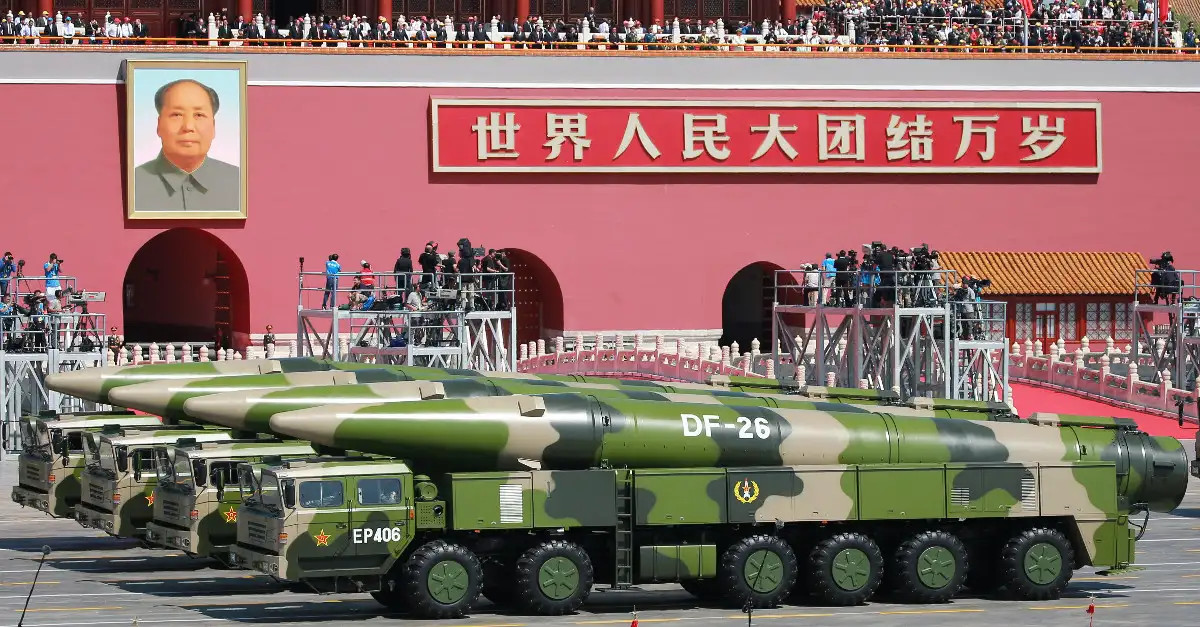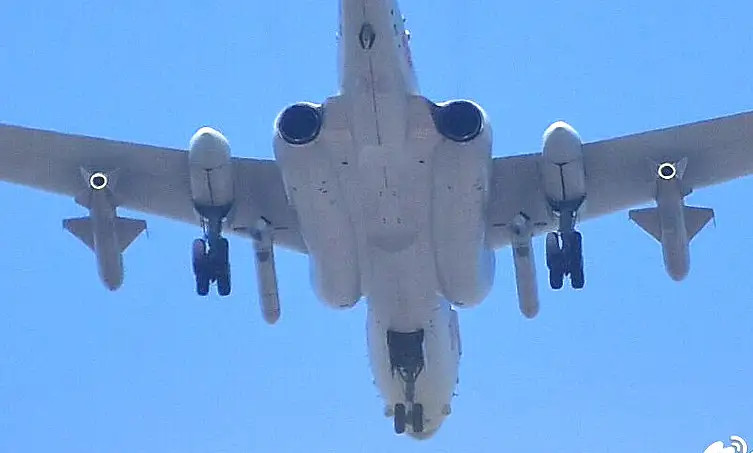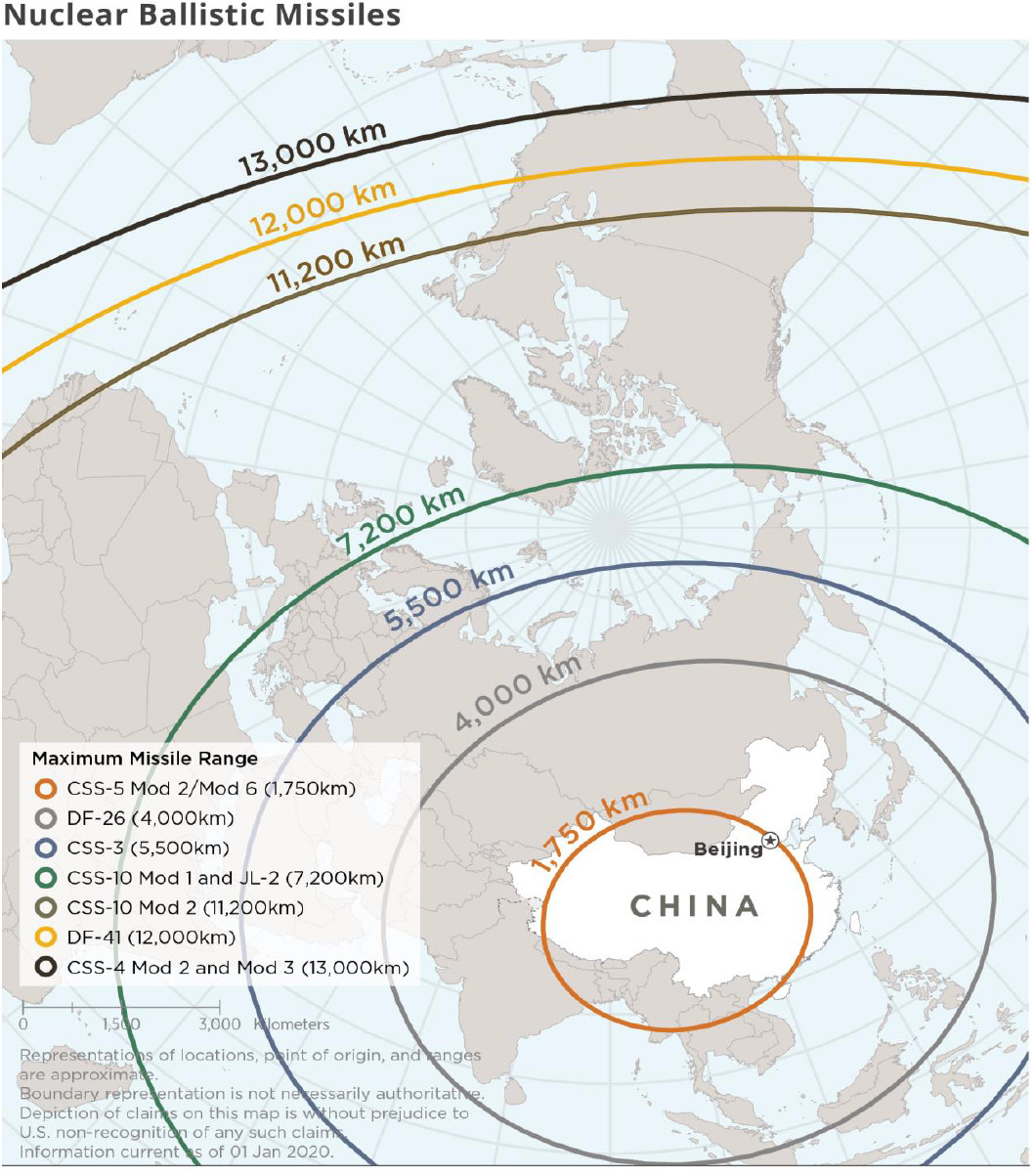A new report from the Pentagon offers an updated public assessment of China’s ballistic missile arsenal, which shows a notable increase in its size and the scope of its capabilities. The annual review of the Chinese military also indicates that these developments are, at least in part, tied to important developments in the country’s nuclear posture and the doctrine and policies surrounding it.
The Pentagon released the latest iteration of its report on the Chinese military and its capabilities, an updated version of which it is required to send to Congress every year, by law, on Sept. 2, 2020. It warned that the People’s Liberation Army is continuing to make strides in a variety of important and advanced technologies, including, but certainly not limited to hypersonic weapons, artificial intelligence, cyber warfare, counter-space systems, air defenses, and the construction of large capital ships and advanced submarines. The review’s discussion about ballistic missiles and nuclear capabilities, including a first-ever public estimate from the Department of Defense about the size of the Chinese nuclear arsenal, was especially significant.
“The PLARF [People’s Liberation Army Rocket Force] develops and fields a wide variety of conventional mobile ground-launched ballistic missiles and cruise missiles,” the report said. “The PRC [People’s Republic of China] is developing new intercontinental ballistic missiles (ICBMs) that will significantly improve its nuclear-capable missile forces.”
The Pentagon estimates that China has added 10 new ICBMs to its arsenal since its 2019 report, as well as 10 more launchers, including silos and road-mobile transporter-erector-launchers, to fire them. This brings to the estimated size of the country’s total operational IBCM force from 90 to 100.
The most notable addition are examples of the new DF-41 ICBM, also known to the U.S. intelligence community as the CSS-X-20, which reportedly has the ability to deploy Multiple Independently Targetable Reentry Vehicle warheads, or MIRVs, allowing a single missile to strike multiple targets. You can read more about the DF-41, which represents a significant technology leap over previous Chinese ICBMs and that the Chinese government publicly paraded for the first time last year, in this past War Zone piece. China has also been developing DF-5C and DF-31B variants of those existing ICBM types.

There is no year-over-year change in the number of short-range ballistic missile (SRBM) and medium-range ballistic missile (MRBM) launchers, though the number of total missiles in both cases have been revised. In 2019, the Pentagon said that China had between 750 and 1,500 SRBMs and between 150 and 450 MRBMs, while it simply said that the country had more than 600 SRBMs and more than 150 MRBMs in 2020. SRBMs are defined as ballistic missiles with ranges between 300 kilometers (186 miles) and 1,000 kilometers (621 miles), while MRBMs can reach distances of between 1,000 kilometers (621 miles) and 3,000 kilometers (1,864 miles).
The most dramatic change in the Pentagon’s assessment of the PLARF’s ballistic missile inventory between 2019 and 2020 was with regards to intermediate-range ballistic missiles (IRBM), which have ranges between 3,000 kilometers (1,864 miles) and 5,500 kilometers (3,417 miles). At present, China’s sole operational IRBM is understood to be the DF-26, “which is capable of conducting both conventional and nuclear precision strikes against ground targets, as well as conventional strikes against naval targets,” according to the Pentagon. The Chinese military highlighted its long-range anti-ship ballistic missile capabilities in a recent major exercise in the South China Sea.

The new report says that the total number of DF-26 road-mobile transporter-erector-launchers has surged from 80 to 200, while the total number of actual missiles has risen from between 80 and 160 to over 200. The DF-26 is rapidly becoming one of the most important missiles in China’s arsenal, but there does not appear to have been any public discussion from Chinese authorities about such a significant expansion of this part of the PLARF. The Pentagon offers no context for how it arrived at this estimate.


Adding 120 new TELs would very likely reflect a notable increase in the overall DF-26 force, as well as supporting elements and infrastructure. Experts have openly questioned whether this might be a typo, with the launcher figure being an accidental copy-paste of the missile figure, or some kind of other error. There is at least one clear quantitative error elsewhere in the new Pentagon report, with another section of the text saying the PLARF only has 200 SRBM launchers, instead of 250, as found in tables in both the 2020 and 2019 editions.
In addition to the ground-based ballistic missiles, the Pentagon report also notes that the People’s Liberation Army has six Type 094 Jin class ballistic missile submarines, “four operational and two outfitting at Huludao Shipyard,” each of which can carry up to 12 nuclear-tipped JL-2 submarine-launched ballistic missiles. The combination of the Type 094s and the JL-2s, which China also paraded publicly last year, represent “the country’s first viable sea-based nuclear deterrent.” The Chinese are also working to develop a follow-on ballistic missile submarine, known as the Type 096, as well as an improved submarine-launched ballistic missile, the JL-3.

The DOD report also raises the possibility that the People’s Liberation Army Navy’s Type 055 warships, which it classifies as cruisers, rather than destroyers, may be able to carry anti-ship ballistic missiles of some kind in the future. It has been previously reported that the CM-401 short-range anti-ship ballistic missile, which the China Aerospace Science and Industry Corporation unveiled in 2018, might be a future armament for the Type 055. The assessment does not appear to be talking about the integration of larger ballistic missiles, such as anti-ship variants of the DF-21 or DF-26, onto these ships.
“In October 2019, China signaled the return of the airborne leg of its nuclear triad after the PLAAF publicly revealed the H-6N as its first nuclear-capable air-to-air refuelable bomber,” the report adds. “The H-6N features a modified fuselage that allows it to carry externally either a drone or an air-launched ballistic missile (ALBM) that may be nuclear capable.”

The report further notes that China continues work on a reportedly flying wing-type stealth bomber, known as the H-20, but it remains unclear when that aircraft may enter service. You can read more about the H-20 in these past War Zone pieces. There is no mention of a potential advanced regional bomber program, which the Defense Intelligence Agency discussed in its public report last year and is commonly referred to as the JH-XX. You can read more about that aircraft in this previous War Zone story.
The Pentagon says that these developments are, at least in part, a component of broader efforts to expand the size and scope of the People’s Liberation Army’s nuclear capabilities. The 2020 assessment includes, for the first time ever, an estimate of how many nuclear warheads China has – “in the low-200s” – with the possibility of that stockpile doubling in the coming years. As many as 200 warheads may be capable of threatening the United Staes within the next five years, according to the review.


The report offers limited detail about how the Pentagon arrived at this assessment, saying that it is due in part to the expected introduction of more MIRVed DF-41s. However, it also says “China probably has enough nuclear materials to at least double its warhead stockpile without new fissile material production,” but that it “will require increased nuclear warhead production” in order to make this a reality. The “low-200s” warhead estimate is also notably lower than past Defense Intelligence Agency assessments, as well as those from experts outside of the U.S. government, and may only reflect deployed weapons and not those held in reserve.
This assessment itself is based in part in the Pentagon’s belief that China is looking to reorganize and improve its nuclear forces to better withstand a potential first strike. It says specifically:
“The PRC’s nuclear weapons policy prioritizes the maintenance of a nuclear force able to survive a first strike and respond with sufficient strength to inflict unacceptable damage on an enemy. China is enhancing peacetime readiness levels for these nuclear forces to ensure their responsiveness. In addition, China insists its new generation of mobile missiles, with warheads consisting of MIRVs and penetration aids, are intended to ensure the viability of its strategic nuclear forces in the face of continued advances in U.S. and, to a lesser extent, Russian strategic ISR [intelligence, surveillance, and reconnaissance], precision strike, and missile defense capabilities. India also plays a factor in China’s nuclear threat perceptions.”
Part of this increased peacetime readiness could include the expansion of the PLARF’s silo-based ICBM force, according to the Pentagon. With regards to this development, it says:
“Commercial imagery from 2019 has revealed that China has constructed an ICBM silo at one of the PLARF’s Western training ranges that is smaller than China’s existing CSS-4 (DF-5) silos. According to state media, the CSS-X-20 (DF-41) ICBM can be launched from silos; this site is probably being used to at least develop a concept of operations for silo basing this system. There are also some indications that China may be building new CSS-4 (DF-5) ICBM silos.”
…
“Their size precludes use by the DF-5 and may support concept development for a silo-based DF-41 or one of China’s smaller ICBMs. When taken with China’s past concerns about silo survivability and ongoing strategic early warning developments, these new silos provide further evidence China is moving to a LOW [launch-on-warning] posture.”
Launch-on-warning refers to a nuclear deterrent policy to launch a massive counterstrike upon detecting incoming nuclear threats. This helps ensure that a retaliatory strike can be successfully initiated before the hostile weapons reach their targets.
The Federation of American Scientists (FAS) was the first to spot the silo at the PLARF’s nuclear missile training site near Jilantai in the Gobi Desert and released its own assessment in September 2019. FAS said that it was possible that this silo, which is a distinctly different design from the ones China uses for the DF-5, could be part of the development of an alternate basing option for the DF-41 or for some other future solid-fuel ballistic missile.

However, at present, there does not appear to be any further public evidence of new Chinese silo construction for the DF-41 to further support the Pentagon’s assessment. There is also mention of possible rail-mobile DF-41s, something China reportedly tested in 2015, but it is unclear how seriously the PLARF is exploring this capability. The Soviet Union notably did deploy a similar system during the Cold War, the RT-23 Molodets, and Russia more recently looking into bringing that capability back before shelving those plans in favor of missiles armed with nuclear-armed hypersonic boost-glide vehicles, known as Avangard.
The Pentagon also separately said that China’s nuclear arsenal could grow to include new warheads, including a potential lower-yield warhead for the DF-26, and new delivery systems. A lower yield nuclear weapon could indicate that the Chinese military may bee looking at a so-called escalate-to-deescalate policy, in which a limited nuclear strike could be used to bring a quick end to a conflict before outside powers might be able to intervene or to otherwise dissuade them from doing so. The U.S. government says that Russia has such a policy in its nuclear doctrine, but experts dispute that it exists.
The U.S. government has accused China, as well as Russia, of conducting low-yield nuclear tests in violation of international agreements, which could support the development of new nuclear weapons, but has not publicly provided evidence to substantiate this. In addition, as The War Zone, among others, has pointed out in the past, so-called sub-critical nuclear testing, in which there is no actual nuclear detonation, is permitted under existing arms control regimes and the U.S. conducts such experimentation, as well.
All of this comes as the United States is engaged in negotiations with Russia about extending the New Strategic Arms Reduction Treaty (START), which limits the number of nuclear warheads and various strategic delivery systems that each country can have, and is otherwise set to sunset next year. The U.S. government has been campaigning to bring China into the discussions and potentially expand the deal into a trilateral arrangement.
China has expressed virtually no interest in doing so. Beyond a spike in geopolitical friction with Washington over a host of different issues, Beijing is unlikely to see any benefit in making itself a party to such an agreement in the near future given that its existing nuclear arsenal is so small compared to that of the U.S. and Russian militaries. The Pentagon looks to be making a case in its latest China assessment for getting them to accept limits now before they can expand the size of their stockpile. Chinese officials have already countered these calls by saying it would be willing to talk nuclear arms control with the United States if it agreed to reduce its arsenal to China’s level first.
Whether or not the Chinese grow their ballistic missile and nuclear forces in the ways that the Pentagon expects, it is clear that the People’s Liberation Army is working to significantly expand its capabilities in both regards to better challenge the United States, as well as other potential adversaries.
Contact the author: Joe@thedrive.com
